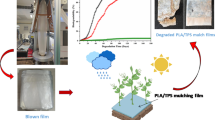Abstract
Two drying schedules, a higher- and a lower temperature drying schedule, were tried on sawn boards from youngEucalyptus globulus andEucalyptus camaldulensis grown in Ethiopia. The aim of the study was to investigate the effect of the two schedules on seasoning degradation and to develop recommendations concerning drying schedules for the examined timbers. Both seasoning schedules gave satisfactory degradation results for 32 mm thick juvenileE. globulus andE camaldulensis boards, even though the degradation obtained using the low temperature drying in most cases was slightly lower than using the high temperature drying. The boards ofE. camaldulensis generally proved to have less degradation than the boards ofE. globulus in this study. The conditioning of kiln dried materials in the conditioning room has reduced the extent of seasoning degradation in most cases. Kiln conditioning has also reduced deformation values to a certain extent, but often not checking values. In evaluating the differences between the upper- and butt logs, it is found that there were no consistent differences between them, except that the 2m longE. camaldulensis boards from butt logs had more deformation than those from upper logs. End sealing with silicon paste gave generally better results than unsealed boards with both drying schedules.
Zusammenfassung
Mit je einem Trocknungsplan bei hoher und niedriger Temperatur wurde Schnittholz vonE. globulus undE. camaldulensis (Äthiopien) getrocknet. Anhand der Versuche sollten Trocknungsschäden bestimmt und günstige Bedingungen für die Trocknung dieser Schnitthölzer erarbeitet werden. Beide Verfahren lieferten befriedigende Ergebnisse für 32 mm dicke Bretter, wenn auch die Trocknungsschäden bei niedriger Temperatur etwas geringer ausfielen. Bretter ausE. camaldulensis neigten im Allgemeinen weniger zu Trocknungsschäden. Durch Konditionieren konnte das Ausmaß der Schäden reduziert werden. Auch die Verformung wurde dadurch bis zu einem gewissen Grad unterdrückt, nicht aber die Rißbildung. Zwischen den Brettern aus oberen und unteren Stammteilen gab es keine durchgängigen Unterschiede, außer daß 2 m lange Bretter vonE. camaldulensis aus den unteren Stammteilen Verformungen aufwiesen als aus der oberen Stammteilen. Endversiegelung mit Silikonpaste verbesserte die Ergebnisse beider Trocknungsverfahren.
Similar content being viewed by others
References
Alexiou, P. N. 1991: Optimisation of an accelerated drying schedule for regrowthEucalyptus pilularis Sm. Holz Roh- Werkstoff 49:153–159.
Bariska, M. 1992: Collapse phenomena in eucalypts. Wood Sci. Technol. 26:165–179
Davidson, J. 1989: Eucalypt tree improvement and breeding. UNDP. Unpublished consultant report Field document No 1, 1988
Hillis, W. E.;Brown, A. G. 1978: Eucalyptus for wood production. CSIRO. Div. of Building Research, Melbourne and Div. of Forest Research, Canberra
Kubler, H. 1987: Growth Stress in Trees and Related wood Properties Review Article. Forestry Abstr. 48(3):131–189
Malmquist, L. 1984: Compound drying of timber. An analysis of drying defects. Final Report. The Swedish Institute for Wood Technology. Wood Technology Report No. 62
Morén, T. 1993: Creep, deformation and moisture redistribution during Air convective wood drying and conditioning. Doctoral Thesis, Department of Wood Technology. Luleå University of Technology.
Neumann, R. J.;Saavedra, A. 1992: Check formation during the drying ofEucalyptus globulus. Holz Roh- Werkstoff 50:106–110.
Pandey, C. N.;Sharma, S. N.;Singh, H. P. 1988: Kiln seasoning schedule forAlbizia odoratissima. J. Ind. Acad. Wood Sci. 19(1):9–17.
Pratt, G. H. 1986: Timber drying manual. BRE. Department of the Environment, Report (sec.ed.)
Pohjonen, V. 1989: Establishment of fuelwood plantation in Ethiopia. Silva Carelica 14:388p. University of Joensuu
Simpson, W. T. 1992: Drying technology issues in tropical countries. IUFRO All-division 5 “Forest Products”. Nancy, France: IUFRO; 1992: 497–507.
Standards Association of Australia 1979: Australian Standards 2082–1979. Visually stress-graded hardwood for structural purposes. Standards Association of Australia, Sydney, 32p.
Standards Association of Australia 1985: Australian Standard 2796–1985. Timber seasoned hardwood-milled products. Standards Association of Australia, Sydney, 32p.
Author information
Authors and Affiliations
Additional information
Financial support for this study was sponsored jointly by the Swedish Development Authority (SIDA) and the Alemaya University of Agriculture
Rights and permissions
About this article
Cite this article
Bekele, T. Kiln drying of sawn boards of youngEucalyptus globulus Labill. andEucalyptus camaldulensis Dehnh. grown on the Ethiopian Highlands. Holz als Roh-und Werkstoff 52, 377–382 (1994). https://doi.org/10.1007/BF02615388
Issue Date:
DOI: https://doi.org/10.1007/BF02615388




